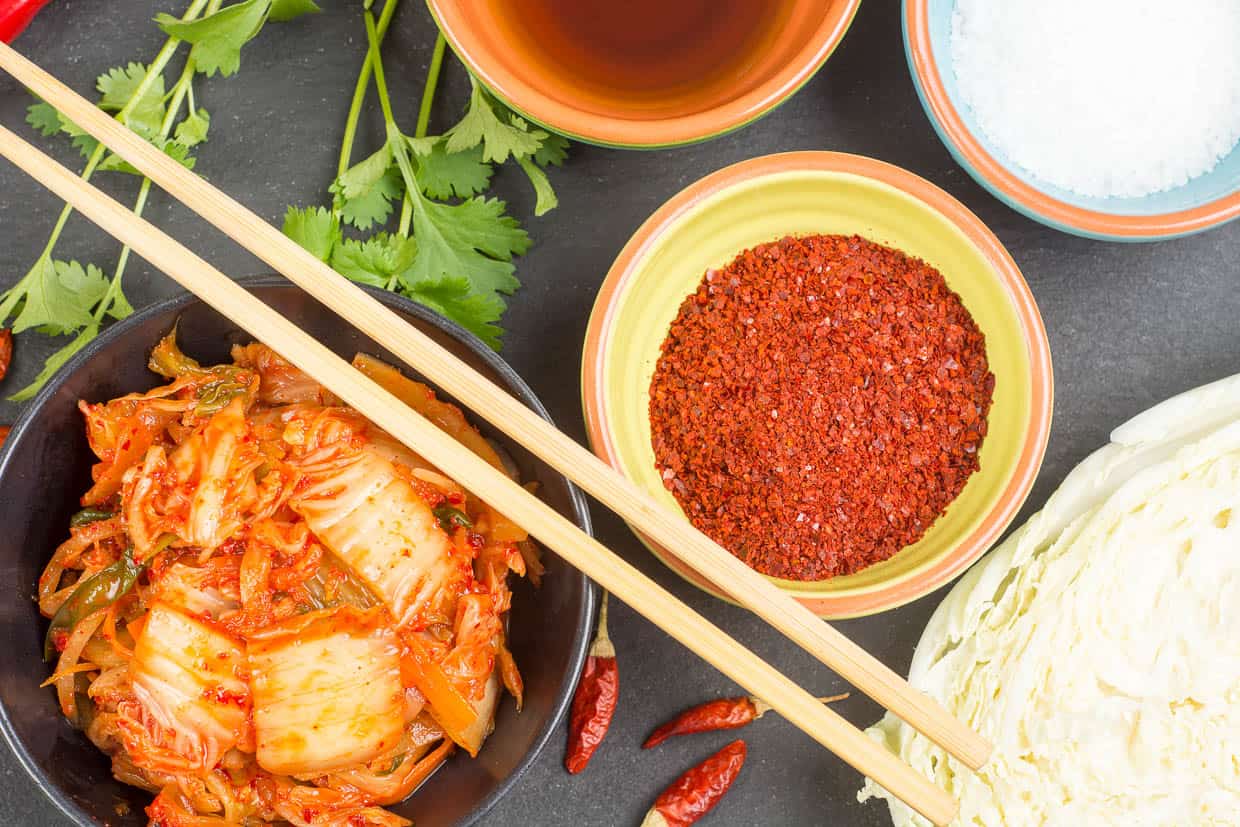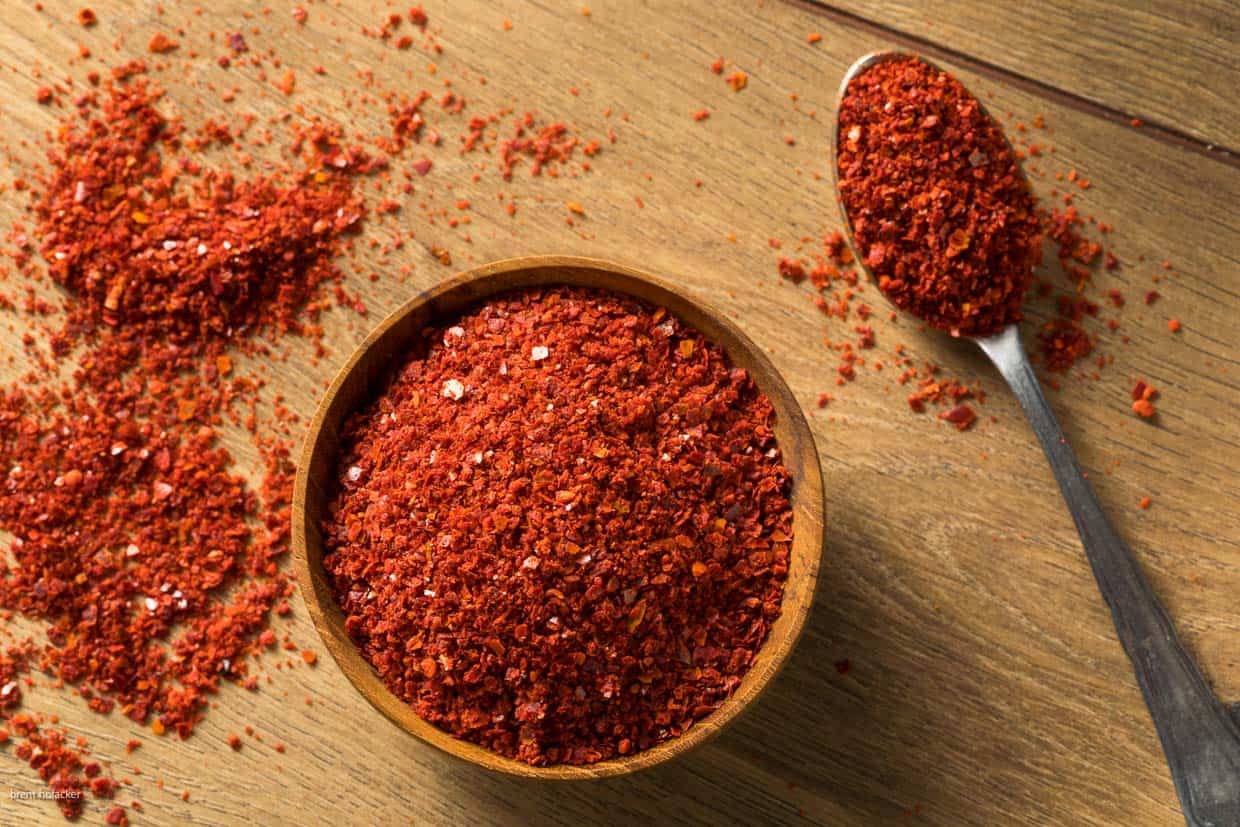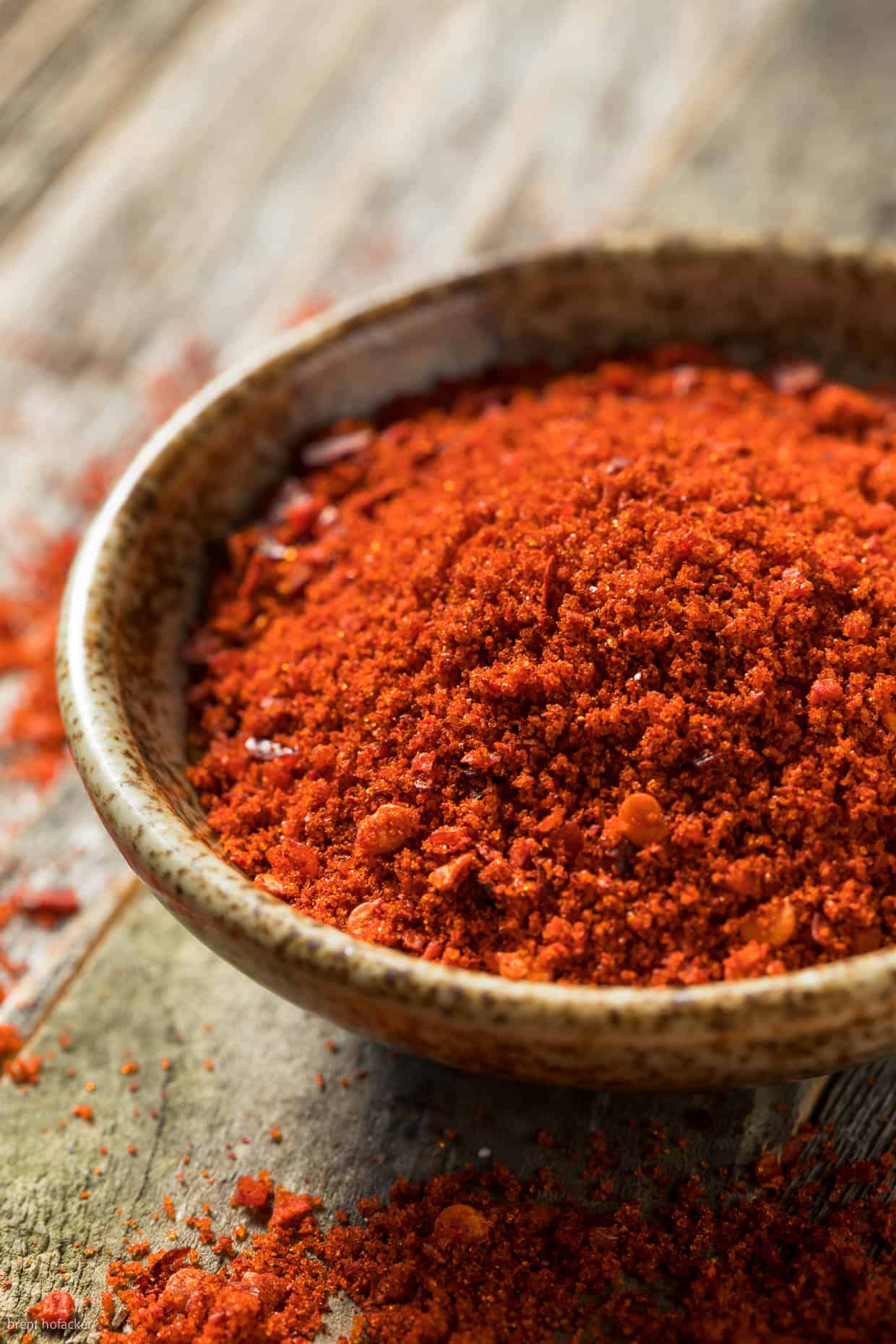Gochugaru is Korean cuisine’s secret weapon. This dried hot pepper powder provides both heat and flavor to Korean dishes.

What is Korean chili powder?
Korean chili powder, Korean chili flakes, or Korean hot pepper flakes are all synonymous with gochugaru — “gochu” means chile pepper and “garu” means powder. Whatever you call it, this bright red Korean red chili powder consists of crushed sun-dried chili peppers — and it packs a wallop.
To make gochugaru, chile peppers, like taeyang-cho or cheongyang peppers, are dried in the sun and then crushed or ground to a fine powder or a coarse grind with some larger flakes.
The powder and coarsely ground versions have slightly different uses in Korean cuisine. The bright crimson, finely powdered red chili pepper is one of the primary ingredients in gochujang, a fermented red chili paste, and dishes when you want to avoid adding texture. The roughly crushed flakes appear in dishes like kimchi.
Gochugaru is a fundamental element in Korean cooking. Many Korean dishes like cucumber kimchi, bibimbap and jjigae, benefit from its peppery kick.
Gochugaru in Korean cuisine
In Korean culture, gochugaru is more than just an ingredient; it’s a staple that has shaped the identity of Korean cuisine and its people. The art of making gochugaru is a traditional practice, passed down through generations. The time of harvesting and drying the chilies, known as “gochu maligi,” is a communal event, often involving the entire neighborhood or village.
The taste of gochugaru can evoke a sense of nostalgia for Koreans as the spice plays an important role in significant cultural events, like the annual kimchi-making tradition called “kimjang,” where families or communities come together to prepare large quantities of kimchi for the winter.
“I first learned about gochugaru when I started making gochujang caramel cookies. The chili powder has a slightly sweet taste to it, which sets it apart from other chili powders. If possible, buy the sun-dried gochugaru, as it tends to be a higher quality with better flavor and more intense color.”
— Michelle Price, Honest and Truly
Gochugaru in fusion cooking
Outside of traditional Korean cuisine, chefs worldwide are beginning to recognize the unique flavor of gochugaru and incorporate it into their own cooking. Its bright, fruity flavor and smoky heat make it a distinctive addition to many dishes. From Mexican-Korean fusion tacos topped with gochugaru-infused salsa to American Southern-Korean fusion barbecue sauces, gochugaru is expanding its reach beyond traditional Korean dishes.
Health Benefits of Gochugaru
Gochugaru, like all hot peppers, can offer several health benefits. The capsaicin in chili peppers can aid digestion, manage weight and may decrease the risk of cardiovascular diseases. Capsaicin is also known for its anti-inflammatory and pain-relieving properties. Furthermore, chili peppers are rich in vitamin A, supporting eye health, and vitamins C and E, both powerful antioxidants.

What is the difference between gochugaru and gochujang?
Both gochujang and gochugaru are common ingredients in authentic Korean cooking, but they are different. Gochugaru is made of crushed or ground dried chili peppers, whereas gochujang is a fermented paste made with chiles and other ingredients.
FDL’S 75 Best Bites

Our cookbook with 75 tasty recipes will be your go-to kitchen companion for easy dinners with ad-free recipes right at your fingertips. Crafted by experienced chefs and recipe developers, this collection offers a treasure trove of tried-and-true dishes that make mealtime a breeze.
Get the Recipe: FDL’S 75 Best Bites
To make gochujang, ground chili peppers, glutinous rice, fermented soybeans and salt are combined and left to ferment for many weeks. The result is a thick, spicy paste with a rich, savory flavor.
Gochujang serves as the foundation for sauces, marinades and dips. It also seasons foods like gochujang chicken, beef bulgogi or Korean fried chicken.
Gochugaru, on the other hand, is produced from coarsely crushed sun-dried chili peppers. It’s a dark crimson powder with a smoky, spicy taste. It is an essential ingredient in kimchi, soups and stews.
While gochujang and gochugaru both provide fire and flavor to Korean food, they are utilized differently and have unique characteristics. Gochujang has a savory, umami flavor that provides the foundation for many sauces and marinades. Gochugaru is a spice with a smoky, spicy taste and is popular for seasoning and adding a spicy kick.
You may use gochujang as a basis in a recipe and then add gochugaru to alter the spiciness and taste. Furthermore, gochujang is the way to go if you want a more complex, savory flavor and thicker texture. Choose gochugaru for a smoky and spicy flavor.

Where to buy it
Gochugaru is available in most Asian grocery stores and online. Look for one without additives, such as sugar or MSG. There are also different types of gochugaru — hotter or milder and flakes or powder.
“Gochugaru lends a spicy, somewhat sweet, smoky flavor to any dish it’s added to and adds a beautiful vibrant red color. I love using it in soups, stews or fresh dishes like salads.”
— Gen La Rocca, Two Cloves Kitchen
How to use it in your cooking
Here are some suggestions for using gochugaru in your cooking:
- Add a tablespoon to your next pot of chili for a smoky, spicy kick.
- Add an extra kick to spicy miso ramen or Singapore noodles.
- Use it in a marinade for chicken, pork or beef with miso paste or soy sauce and sesame oil.
- To make a spicy snack, sprinkle it over potato chips, sweet potato chips or popcorn.
- Mix it with mayonnaise or sour cream to make a spicy dip.
- Use it as a
pizza or nacho topping, or sprinkle it over chilaquiles. - To make a spicy stir-fry sauce, combine it with soy sauce, rice vinegar and sugar.
- Add a tablespoon to your next batch of mac and cheese for a spicy twist.
What is a good gochugaru substitute?
If you can’t locate gochugaru, here are some alternatives:
- Combine cayenne pepper and smoked paprika.
- Combine chili powder and crushed red pepper flakes.
- Combine ground Aleppo pepper with Kashmiri chili powder or cayenne pepper.
- Replace the chili powder with another, such as Kashmiri chile powder or ground cayenne pepper.
Tips for success
It’s easy to incorporate gochugaru into your own cooking with these helpful tips:
- Some gochugaru will be spicier and some milder, and it’s hard to tell from looking at it. It’s best to start with a small amount and add more to taste.
- Because the color might fluctuate, you can’t evaluate the heat degree or depth of flavor only by its appearance. You’ll have to try a few until you find one that suits you.
- Store your gochugaru in an airtight jar in a cool, dry place for up to six months.
Gochugaru is a versatile and delicious red pepper powder that provides depth and flavor to various foods. Try your hand at using it in traditional Korean cooking or play around with using it as a unique seasoning in other cuisines.
Robin Donovan is the author of more than 40 cookbooks, including the bestselling ”Campfire Cuisine,” ”Ramen Obsession,” and ”Ramen for Beginners.” A food writer, recipe developer, and food photographer, she is the creator of the food blog All Ways Delicious, where she shares easy recipes for the best dishes from around the world.
This article originally appeared on All Ways Delicious.